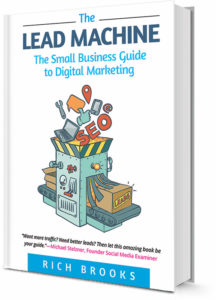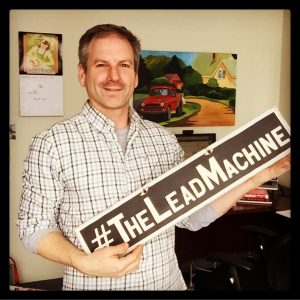 How long does it take to write a book? I can say it took me sixty hours, or ten months, or six years, or twenty. Depends how you look at it.
How long does it take to write a book? I can say it took me sixty hours, or ten months, or six years, or twenty. Depends how you look at it.Sixty hours.
The writing of The Lead Machine: The Small Business Guide to Digital Marketing, took me sixty hours.
I had heard from countless people that writing a book was the most difficult thing they ever did. That it was an absolute grind. That it was as painful as giving birth.
Based upon what my mother has told me about my own birth, I knew this couldn't be true. First of all, she was in labor for twice as long as it took me to write the book.
Regardless, I actually enjoyed the process. Because I work better with goals, I started a spreadsheet that tracked my progress. It included five columns:
- Date
- Hours Spent
- Total Words
- Words Written (that day)
- Words Per Hour
Having the date in there was a clear reminder—and visual reprimand—if I missed a day.
I had promised myself that I’d work at least an hour a day on the book, and for most days I did.
I wrote the first draft in Google Docs so it was easy to get a total word count at the end of each session. I then set up a formula to compute and enter the Words Written for the day.
Finally, the spreadsheet calculated the words per hour I was writing, and also totaled my average, which turned out to be just over 1,000 words an hour. This kept me motivated to keep my head down and focus on my writing during these sessions.
Having the spreadsheet definitely held me accountable and was part of the reason I was able to write the first draft in sixty hours. (Fifty nine point five, if you want to be exact.)
Ten Months
Of course, the writing is the fun part. Editing is the work.
At least it was for me. When I completed the first draft, about a month earlier than I had expected, I followed the advice of my friend, my book coach, and author of The Profitable Business Author, Julie Ann Eason, who told me to take two weeks off from the book. Get some space and let everything settle.
Fourteen days later I walked into Staples, printed up the manuscript and put it in a blue binder. Per Julie’s recommendation, I read the book out loud to myself, marking it up with a red pen.
I killed that red pen.
There were parts of the book that were unclear, repetitive, or just didn’t make any sense. There was bad English and worse puns. There was grammar that didn’t look, act, or smell like grammar.
There were also some nice surprises. A number of times I read a passage that I didn’t remember writing and it made me laugh out loud.
That wasn’t the last time I had to read the book. Once I completed it and made the changes to the digital file, I handed it off to an editor who reviewed and marked up the file. I then had to read the book again and agree or disagree with her changes.
Once I got the book professionally formatted I had to read it again, to pick up additional mistakes. That process actually took five iterations, but I can promise you I didn’t read it through each time.
I also went through a process getting the cover designed. The designer I hired created three versions based on my input, each with a unique piece of stock illustrations that was meant to represent the idea of the book. Only after seeing them did I realize that I wanted an original illustration that would represent the book and no one else could use.
So, I turned to my friend Josh Fisher, who had done the designs for the Agents of Change as well as some other art for me over the years, and he came up with what can only be described as a Lead Machine.
Once that was completed, I uploaded everything to CreateSpace (to turn it into a paperback that can be sold on Amazon) and KDP, which turns it into a Kindle book.
Because sometimes the upload gets wonky, you’re supposed to read through it again to find mistakes, both for the paperback and Kindle version. I skimmed.
They never tell you how often you’re going to read your own book before publication.
Funny aside: I was using CreateSpace to upload my paperback to Amazon, but it was taking too long and I was getting distracted, so I decided to come back when I had a bigger block of time.
Two days later I returned, only to find out not only had I completed the process but I’d sold two copies! Perhaps not the most auspicious of beginnings, but it was cool to see that two people had already purchased copies without me promoting it.
When I told my younger daughter, she immediately told me that it was she and Grammy Mar who bought them. (She was kidding.) (I think.)
Six Years
Ever since 2010 I’ve included “writing a book” on my annual goals list. Usually right at the top.
Why it took so long I can’t say. I got busy, things came up, I spent my time working on other projects. I’ve got plenty of good excuses, and even more poor ones.
When I finally realized that not having a book was holding me back professionally, I decided to get serious. For me, that meant hiring a coach. I’ve found that often it’s important to have skin in the game. Once I started paying Julie for her one-on one-coaching, something clicked inside me and I got to work.
I’m not suggesting that everyone needs a book coach to get the work done, but sometimes making a personal investment is the motivation you need to move forward.
Twenty Years
That’s how long I’ve been doing this. Or more specifically, it’s been twenty years since I started building websites and marketing businesses online. Hundreds of clients, over a dozen employees, and countless hours blogging, podcasting, optimizing, and marketing later, I had enough experience to take the book that was in my mind and bring it into the world.
In that time I’ve worked with so many people, businesses, and organizations. Each one different, each one unique, and yet there was one thing that seemed to connect them. The need to generate leads online, whatever “leads” meant to them.
By working with such a wide variety of businesses—boat builders to business consultants, furniture makers to dentists, innkeepers to authors—I started to see a framework that almost every business could use to make sense of their digital marketing. What I call the BARE Essentials of Digital Marketing:
- Build – How to build a platform where you can turn visitors into customers
- Attract – How to drive qualified traffic to your site, with a focus on search, social, and digital ads
- Retain – How to stay in touch with people after they’ve left your site
- Evaluate – How to measure and understand your site traffic, social engagements, and other marketing campaigns to determine what’s working and what’s not
What happens now
 There’s still work to be done. The promotional push (of which this blog post is part.) The launch party, where books will be signed and bourbon will be consumed. An attempt to get the book into local bookstores. And a whole lot more.
There’s still work to be done. The promotional push (of which this blog post is part.) The launch party, where books will be signed and bourbon will be consumed. An attempt to get the book into local bookstores. And a whole lot more. It turns out writing is the easy part when it comes to authoring a book. ?
If you’re looking for a good read (he says, biased,) and want to generate more leads from your website, consider grabbing a copy of The Lead Machine from Amazon.
If you have any questions about the book, or about the process of birthing a book, please let me know in the comments below.
